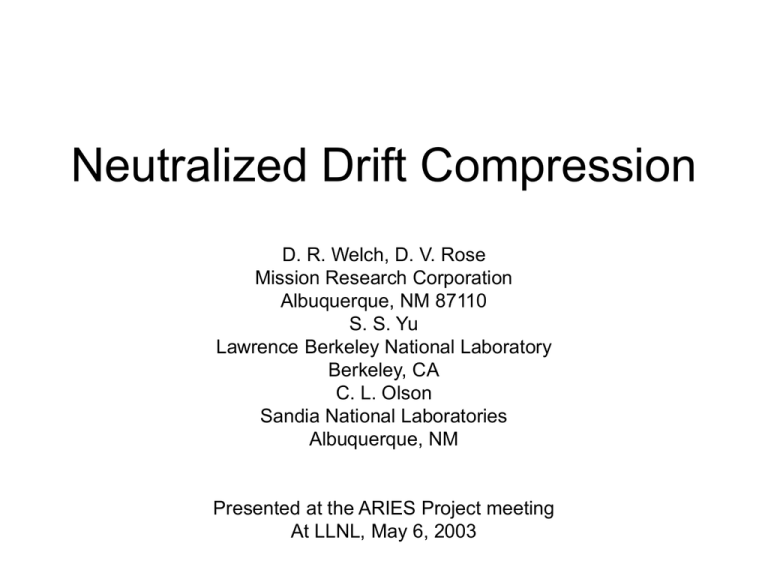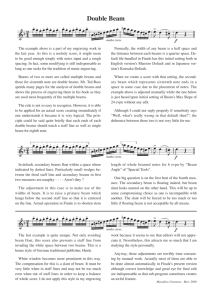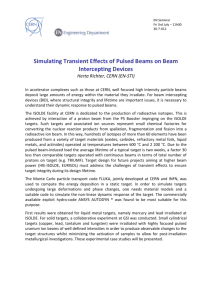Power Point
advertisement

Neutralized Drift Compression D. R. Welch, D. V. Rose Mission Research Corporation Albuquerque, NM 87110 S. S. Yu Lawrence Berkeley National Laboratory Berkeley, CA C. L. Olson Sandia National Laboratories Albuquerque, NM Presented at the ARIES Project meeting At LLNL, May 6, 2003 Beams must combine in all HIF transport scenarios • For mainline Neutralized Ballistic Transport (NBT), the beams combine right at the target within a 2-3 mm radius • For Assisted Pinched Transport (APT) and Self Pinched Transport, the beams combine at the Adiabatic Discharge Channel within a 1-cm radius • 10-100’s m neutralized drift compression envisioned for modular solenoidal transport Assisted Pinched Transport can reduce chamber focus requirements and reduce driver costs - Back up to NBT Laser 5 Torr Xe 25-50 kA LSP simulation starts Hybrid Target Beams drift, combine and possibly compress in plasma drift region • • 10-80 beams per side Combined beams must focus to a 1-cm spot at the adiabatic discharge channel to couple to hybrid target (0.5-cm radiator - D. A. Callahan, M. C. Herrmann, M. Tabak, Laser and Particle Beams, 20, 405-410 (2002). ) Focusing ion beams 10 cm Plasma drift region Chamber first wall Adiabatic section B 1013-1015 cm-3 10 m 50 kA channel current Goal is determine transport characteristics and stability regimes of compressing/combining beams in neutralizing plasma Hybrid target Final focusing limits beam velocity tilt for compression to a few % • For reasonable length simualtions, we use large tilts and shorter drift lengths • 2D calculations examine the two extremes in beam current – low current and longer drift length (30 m) – high-current but shorter drift length (10 m) • 3D calculations look at high current beam combining • A beam frame calculations would greatly speed these calculations 2D LSP Low-Current Parameters • Ne+ ions • • • • • 100 ns pulse length at injection 2 kA current, rising to 12 kA after 600 ns transport 210 MeV Ne+ 2.5x10-3 perveance injected in r=10 cm radius with 4 -mm-mrad emittance v tilt: beta = .125-.145 in 100 ns (20 ns pulse after 600 ns drift) • Uniform plasma fill of 4x1012 cm-3 density in conical drift tube • LSP* used in direct-implicit mode – Constraints on simulation timesteps and cell sizes are greatly relaxed – Scattering and stripping is ignored * T. P. Hughes, S. S. Yu, and R. E. Clark, Phys. Rev. ST-AB 2, 110401 (1999); D. R. Welch, D. V. Rose, B. V. Oliver, and R. E. Clark, Nucl. Instrum. Meth. Phys. Res. A 464, 134 (2001). Simulation shows good transport • • Resolution becomes coarse for the beam at >600 ns Beam density begins lose sharp edge Net currents increase with distance • Simple theory predicts 100 amp net current for 2 kA beam 1% of plasma density • Beam emittance roughly doubles to 8 -mm-mrad by 600 ns • No surprises 2D LSP High-Current Parameters • Used several ions Ne+, K+, Xe+, Pb+ • Uniform plasma fill with density roughly that of beam peak • Solenoidal field 0-4 kG (uniform over simulation region) • For Ne+: • • • • • 100 ns pulse length at injection 150 kA current (combining 10 beams of 15 kA) 210 MeV Ne+ 0.1 perveance (3 MJ total energy) injected in r=5-10 cm annulus v tilt: beta = .125-.165 in 100 ns (8 ns pulse after 14.5 m drift) • Scaling of heavier mass ion simulation • Same velocity, m x more energy, 1/m x less current • Beam emittance was decreased with mass 10 x 15 kA Ne+ beams without Bz • • • • Ensemble given a 50--mm-mrad emittance (2 cm ballistic spot) Uniform 4x1014 cm-3 plasma density Charge neutralization is excellent – 99.99% neutralized at 160 ns Beam magnetically filaments radially, emittance increases 75--mm-mrad By 180ns, emittance has grown 50% 10 x 15 kA Ne+ beams with Bz=1kG • Filamentation is reduced slightly with applied field • Beam density from 120-280 ns Significant net current at beam edges produce annulii 1 10 Net Current (kA) 4 5000 Scales wtih square root of current - example for 300 kA 0 0.01 • • 0.1 1 10 Ratio of beam to plasma density No applied B field case Roughly 10-20 kA net currents (Amps) force concentric beam annulii to form consistent with theory - D. R. Welch. D. V. Rose, B. V. Oliver, T. C. Genoni, R. E. Clark, C. L. Olson and S. S. Yu, Phys. Plasmas 9, 2344 (2002). Lower perveance beams should be less susceptible 100 10 x 7.5 kA K+ beams show improved transport • • • • 32--mm-mrad beam emittance for a 1.4 cm ballistic spot (K = 0.025) 2x1014cm-3 plasma density K filametation looks tolerable, emittance grows to 42 -mm-mrad Beam density from 120-280 ns 10 x 2.3 kA Xe+ beams • Beam emittance 13 -mm-mrad for a 0.6 cm ballistic spot, grows to 17.5 – K = 2.4x10-3 • • • 6x1013 cm-3 plasma density Coupling to adiabatic discharge channel looks feasible Beam density from 120-280 ns 10 x 1.45 kA Pb+ beams • Beam emittance 9.5 -mm-mrad for a 0.4-cm ballistic spot, grows to 10.7 – K = 9.2x10-4 • • • 4x1013 cm-3 plasma density Stiffer beam shows little filamentation, excellent spot Beam density from 120-280 ns 3D Lsp simulations with ¼ volume • Direct-Implicit cartesian electromagnetic simulations • Symmetry boundaries at y=0 and x=0 • 2 uniform density ion beams of 3-cm radii with edges just touching (slightly asymmetric in azimuth) – models 8 beams in full volume Combined Ne+ beam filament • • • • 4x1014 cm-3 plasma density 5 -mrad-mm emittance Combined beam emittance grows to 86 -mrad-mm Filaments wash out near focus (z > 800 cm) Beam density z=410 cm at 160 ns z=810 cm at 240 ns z=915 cm at 320 ns K+ beams show 2d and 3d filamentation Beam Density • 2x1014 cm-3 plasma • Beamlets have 3 -mrad-mm emittance • 4.4 kG self B fields by 240 ns • Combined beam emittance grows to 15 -mrad-mm Beamlets first radially filament, then the combined beams show m=8 azimuthal mode structure B field Vectors Xe beams combine quiescently • • • • • • Symmetry boundaries at y=0 and x=0 2 Xe+ beams of 3-cm radii 1.7 -mrad-mm emittance 6x1013 cm-3 plasma density Combined beams reach desired 1-cm spot at 1000 cm Combined emittance grows to 15 -mradmm Beam frame option under development for LSP should allow longer transport simulations • 1-cm, 10-kA beam in a 4 x1012 cm-3 plasma example propagated 32 ns in the beam frame Mesh velocity, 0.2 c Beam density Plasma electron density Neutralized Drift Compression Summary • Larger mass ions (eg. Xe+,Pb+) exhibit good transport – should couple to APT transport channels • “Low-current” drift compression of Ne+ over 25 meters shows good transport with 6x compression • Filamentation heats high perveance (low mass) ion beams to higher beam temperatures and larger spots • Solenoidal field reduces filamentation – needs further study • First look at neutralized drift compression for modular solenoidal transport encouraging








